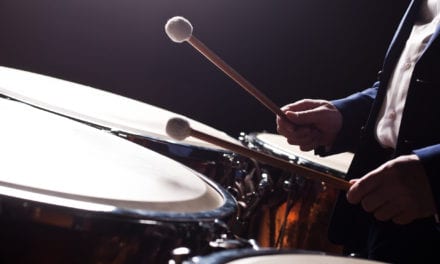Can you imagine if your band didn’t rehearse for five months in the winter and spring? This is an unreal proposal. The musicians could not practice essential preparation to grow musically from year to year. Thus most music programs continue all year long with classroom rehearsals, concerts, festivals and individual practice to fuel their musical abilities. However, color guards often take this unreal path of action. Many color guards finish the fall season only to pack up their equipment until try-outs in the spring. And year after year, new members join, barely have time to learn the essential basics of modern-day pageantry, learn the fall show and are performing every weekend. Although more and more music departments are offering winter guard programs, indoor guard can often be a rewarding performing experience but an expensive and time consuming project for any band. If your school is fortunate enough to have a winter program, continued training and performing ideas are available. But to the rest of the one season color guards, many options can be taken to motivate during the off season. Whether your team has an experienced staff or is student run, color guard throughout the year can take many different paths and lead to adventures that can broaden your ensembles training and performing experiences.
RECRUIT EARLY
Finding new talent in your school with so many student activities is an obstacle. With cheering, dance teams, show choir and musicals often depleting the talent pool, creative recruiting can bring new members. Create a recruiting folder with information from your band director, schedules, testimonials from guard members, and other cool info about your team. This can be very helpful in answering all the questions students and their parents have about band and color guard. Plan a video/ pizza gathering after school or after a weekend basketball game. View favorite band and guard shows and tell stories of why you are involved in pageantry while enjoying the social environment. Go to a local winter guard event as a group. Get information from your director and motivate your team by watching and cheering on your peers. Be sure to include the middle school students they are an untapped gold mine of talent and first-time involvement.
BEGIN REHEARSALS
As with any activity or sport, the more practice, the better the performance. Starting the process of recruiting and setting up rehearsals is as simple as a sign-up sheet and school announcements. As student leaders, speak to your guard staff and /or band director and help with checking schedules, rehearsal locations, making sure equipment is maintained and ready for rehearsing. Perhaps begin with a movement or dance class by a senior dancer or a former member, or even a local dance teacher. A set weekly time could continue year round and even involve other dancers from the school. Conditioning also is a consideration for both body and equipment and preparing the body earlier will enhance the physical abilities. Equipment rehearsals need to be a fun yet slow process. Learning correctly the first time eases future problems. Give examples of right and wrong, allow new members time to learn and grow and be very positive in your comments. Remember how you started, show your inspiration and motivation and reflect the best of what guard does.
CREATE A COLORGUARD GUIDE
Prepare a simple color guard manual for the team. Use this idea as a service project or activity for returning members to use as team bonding. Give information on dance terms, guard exercises and glossary of positions, moves and tosses, motivation ideas and history of bands and pageantry. Use common PC layout and design features and you can a have a very professional look too. The manual can be used as a start for your drill book for the fall and can be passed down to future leaders on your team. This guide may also set the ground rules for the year, the more organized and prepared the team is, the better the performance.
PREPARE A SPRING PERFORMANCE
Create a performance troupe of returning members to perform at your spring music or arts concert. Select a piece of music and prepare a simple piece or routine to showcase your group’s talents. A few short rehearsals with experienced performers can get that added spark back into your team’s motivation for the coming year and can be an excellent recruiting vehicle. Use dance as a solid base in creating your work and show how flags and spinning equipment can be daring and exciting. Gathering previous routine and show ideas and re-working them can allow phrases to come to life with new music. Consider smaller performing areas and smaller ensembles and allow all ideas to give you the best opportunity to help the team.
SPECIAL TRAINING SESSIONS
Invite a color guard or dance expert to give a clinic to your group. A local dance teacher or professional dancer to train for an afternoon or a former guard member who has continued his/her guard career would be a great way to expand your team’s knowledge and to motivate in the down months. This idea could also be expanded and used as a clinic for other local color guards. A full day of dance and color guard in the spring can get the blood rushing to those hands and feet and bring back all the aches and pains of color guard. But preparation should be considered to make any activity a success and involving your directors and parents can insure better success. Spring training in any form will motivate and help maintain a successful color guard program. Using some simple ideas can enhance the future of your program and prepare your team for the coming season.



